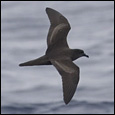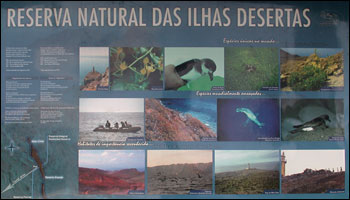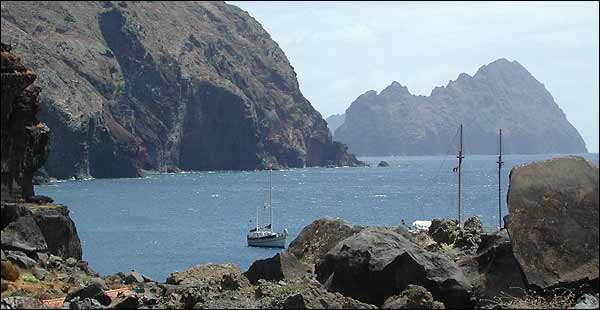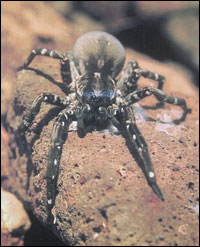
 |
| From left: Chão, Deserta Grande and Bugio (July 2005). Photo: Paul & Andrea Kelly, Ireland. |
 |
| A picture of the information board on Deserta Grande. Photo: Dan Mangsbo, Sweden. |
In 1990 the Desertas became a Nature Reserve, comprising the islands themselves and the surrounding sea to a depth of 100 metres, south from the Research Station at Carga da Lapa and the Fajã Grande on the east. The reserve is divided into two protected zones of which the southern half of Deserta Grande and Bugio are strictly forbidden to visitors even by boat within the 100m barometric line. On the northern half of the reserve boats may come close to shore, but nobody is allowed above the high water mark. On Deserta Grande there is a permanent research station with two wardens, who are the only human inhabitants of the islands today.
Birds
On the islands there are only 15 species of breeding birds, eight of them
being seabirds. Fea's Petrel breeds only on Bugio with 150-200 pairs.
They nest in burrows and it would appear that there is some competition
with rabbits which sometimes invade the burrows and upset the nesting
birds. It has been suggested that rabbits be removed form the island as
a protective measure for the birds. In addition the following species
breed on the islands, the approximate numbers of pairs in brackets: Cory's
Shearwater (>1500), Little Shearwater (>300), Bulwer's Petrel (>1500),
Madeiran Storm-petrel (>1000), and small numbers of Yellow-legged Gull,
Roseate and Common Tern.
The land birds that breed on the islands are: Buzzard,
Kestrel, Rock/Feral Dove, Plain Swift, Berthelot's Pipit, Canary and Linnet.
Of these Kestrel, Berthelot's Pipit and Canary are often the species you
will see as you land on Deserta Grande. Buzzards can be seen flying high
up on the cliffs.
 |
| Ventura do Mar
lay at anchor in the bay Doca, Deserta Grande. Bugio in the background. Photo: Magnus Unger, Sweden, August 2003. |
Animals
Among biologists these islands are well known for the very small colony
of Monk Seals, which was the main reason that the Desertas became a nature
reserve. The population has increased slowly since 1998 when there were
only eight left, to more then 20 today. If you see one you are among the
few lucky ones!
Originally there were no mammals on these islands,
but introduced species such as rabbits, goats, cats and House Mice still
compete for the scarce resources. An EC-Life-project enabled the extermination
of rabbits on Deserta Grande from 1996 to 1998. Out of 220 goats living
on Deserta Grande before 1996, 194 were shot within two years. House Mice,
whose population has been reduced drastically in recent years, have to
disappear from Deserta Grande too. This is all a bit complex. The EU grant
was for the removal of rabbits and goats. It was always said that for
the mice to be removed a greater effort would be needed. Rabbits were
rapidly removed with little problem. Over 700 goats have been shot so
far, but they seem unable to get the numbers down to zero! Sadly, there
are probably over 100 goats there at present and they are breeding like
crazy as with a diminished stock, there is much more grazing and they
are giving birth to 2-3 offspring at a time! As predicted the mice numbers
have risen significantly as there are more seeds from the increased flora
and more insects on the flora. Mice are known to cause problems to the
smaller birds.
 |
| Deserta Grande Wolf Spider. Photo: Claudia Delgado |
Deserta Grande
Wolf Spider (Hogna ingens)
This species of wolf spider represents one of the several endemic invertebrates
inhabiting Desertas. Its length including the legs measures 8 cm and this
makes it the largest spider of its genus in the world. Its population
is restricted to Castanheira Valley on the top of Deserta Grande, where
it lives hidden under rocks and does not construct a web. This poisonous
spider feeds on invertebrates and Madeiran Wall Lizards.
Brief history
The islands were discovered
by João Gonçalves Zarco in 1419/20 during his first voyage
of discovery and named "Desertas" by him. They were only properly
explored in 1420/21 once the island of Madeira had been explored and the
settlement of Funchal established.
The Desertas was the private property of two English
families from Madeira from 1894 to 1971, as were the Salvage islands (the
Selvagens were owned by a Portuguese, Luis Rocha Machado, and were bought
before the Desertas by the State), but in 1971 the Portuguese State bought
them and turned them into Nature Reserves.
Getting there
There are several small boat companies that travel to Desertas from Funchal,
but the boat "Ventura do Mar" (see Pelagic
trips) seems to be the company that most birders choose for all full
day trips or a two-day trip staying overnight and listening to the arrivals
of seabirds after sunset, especially sought after species such as Madeiran
Storm-petrel and Little Shearwater. Ventura do Mar visits Desertas once
a week on fixed dates, so make sure to book in well in advance if you
visit Madeira in July and August!
Acknowledgements
I am grateful to Frank Zino who kindly have provided additional and valuable
information, as well as comments on this piece of text!
Copyright
© 2004-2013,
All rights reserved
Contact: Birding
Madeira